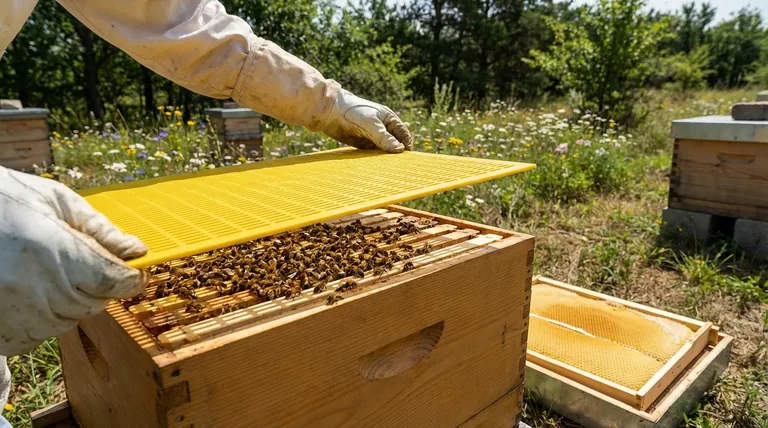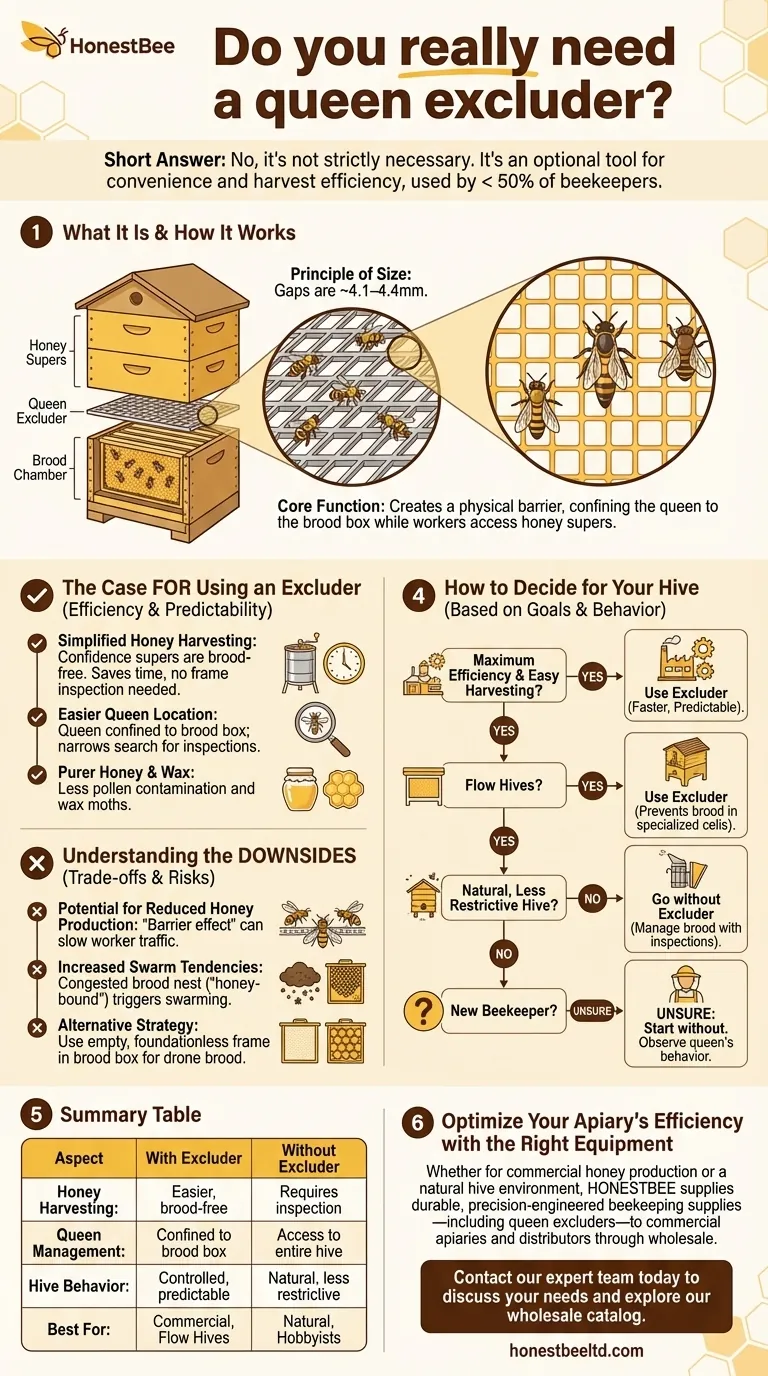No, a queen excluder is not strictly necessary for beekeeping. In fact, it is an optional piece of equipment used by less than half of all beekeepers. Its purpose is to confine the queen to the brood chamber, which keeps her from laying eggs in the honey supers and simplifies harvesting. However, many beekeepers successfully manage their hives and produce honey without ever using one.
The decision to use a queen excluder comes down to a fundamental trade-off: it offers greater management convenience and harvest efficiency at the potential cost of creating a less natural, and sometimes less productive, hive environment.

What a Queen Excluder Is and How It Works
A queen excluder is a simple tool that has a significant impact on how a hive is managed. Understanding its basic principle is key to deciding if it's right for you.
The Core Function
The primary purpose of an excluder is to create a barrier between the brood box (where the queen lays eggs and raises young) and the honey supers (where bees store surplus honey).
This separation ensures that frames in the honey supers contain only honey, not eggs or larvae.
The Principle of Size
The device works by exploiting the size difference between bees. The gaps in the excluder, typically between 4.1 and 4.4 millimeters, are large enough for worker bees to pass through but too small for the larger queen and drones.
This physical barrier allows workers to access the honey supers to deposit nectar while the queen remains confined to the brood boxes below.
The Case for Using a Queen Excluder
Beekeepers who use excluders do so for clear reasons related to efficiency and predictability.
Simplified Honey Harvesting
Using an excluder means you can remove honey supers with confidence, knowing they are free of brood. This saves considerable time, as you don't need to inspect every frame for eggs or larvae before extraction. For commercial operations, this efficiency is critical.
Easier Queen Location
When you need to find the queen for inspections, disease checks, or re-queening, an excluder narrows the search area dramatically. You know she is confined to one or two brood boxes, not wandering across an entire multi-level hive.
Purer Honey and Wax
Keeping brood out of honey supers results in cleaner honey with less pollen contamination. The wax cappings from brood-free combs are also of higher quality and are less attractive to pests like wax moths.
Understanding the Trade-offs and Downsides
Despite the benefits, many beekeepers choose not to use excluders because of the potential drawbacks.
Potential for Reduced Honey Production
Some beekeepers observe that workers can be reluctant to pass through the excluder. This "barrier effect" can slow traffic into the honey supers, potentially reducing the overall rate of honey storage. Providing an upper entrance can help mitigate this.
Increased Swarm Tendencies
By restricting the queen's laying area, the brood nest can become congested more quickly. This sense of being "honey-bound" or overcrowded is a primary trigger for the colony to begin swarm preparations.
The Hobbyist vs. Commercial Mindset
The decision often reflects the beekeeper's goals. Commercial beekeepers typically prioritize the predictable efficiency an excluder provides. In contrast, many hobbyists prefer a less interventionist approach that more closely mimics the colony's natural behavior.
An Alternative Management Strategy
Instead of using an excluder, some beekeepers manage the queen's laying patterns by providing an empty, foundationless frame in the brood box. This encourages the queen to lay her drone brood there, making her less likely to seek space in the supers above.
How to Decide for Your Hive
There is no single correct answer. Your choice should be based on your management style, your goals, and most importantly, your bees' specific behavior.
- If your primary focus is maximum efficiency and easy harvesting: Using a queen excluder will make your process faster and more predictable.
- If you manage specialized equipment like Flow Hives: An excluder is highly recommended to prevent the queen from laying eggs in the specialized honey cells.
- If your primary focus is a more natural, less restrictive hive: Go without an excluder and learn to manage the brood nest through careful and regular inspections.
- If you are a new beekeeper and unsure: Start without one. Observe your queen's behavior to see if she tends to stay in the brood nest or if she consistently lays eggs in your honey frames.
Ultimately, observing your colony's unique tendencies is the best guide to making the right decision for your apiary.
Summary Table:
| Aspect | With Excluder | Without Excluder |
|---|---|---|
| Honey Harvesting | Easier, brood-free supers | Requires frame inspection for brood |
| Queen Management | Queen confined to brood box | Queen can access entire hive |
| Hive Behavior | More controlled, predictable | More natural, less restrictive |
| Best For | Commercial efficiency, Flow Hives | Natural beekeeping, hobbyists |
Optimize Your Apiary's Efficiency with the Right Equipment
Whether your goal is maximum honey production for a commercial operation or supporting a more natural hive environment, having the right tools is essential. HONESTBEE supplies durable, precision-engineered beekeeping supplies and equipment—including queen excluders—to commercial apiaries and beekeeping equipment distributors through our wholesale-focused operations.
Let us help you equip your hives for success. Contact our expert team today to discuss your specific needs and explore our wholesale catalog.
Visual Guide

Related Products
- Professional Plastic Queen Excluder for Modern Beekeeping
- High Performance Plastic Queen Excluder for Beekeeping and Apiary Management
- HONESTBEE 72 Frame Industrial Electric Honey Extractor for Beekeeping
- HONESTBEE 6 Frame Three Use Electric Honey Extractor for Beekeeping
- Wooden Queen Bee Excluder for Beekeeping
People Also Ask
- What are the pros of using queen excluders? Boost Honey Production & Hive Efficiency
- What is the purpose of a queen excluder when adding a super? Streamline Your Honey Harvest
- What is the role of a queen excluder when adding a super? Ensure Brood-Free Honey Harvests
- Why are queen excluders recommended for Flow Hives? Prevent Brood Damage for a Clean Harvest
- How does a queen excluder work? Master Hive Management for Pure Honey Harvests



















